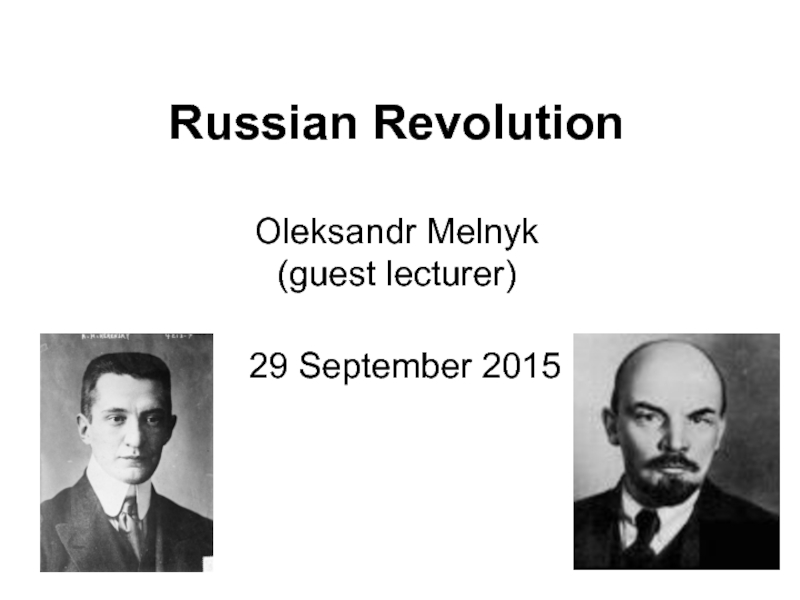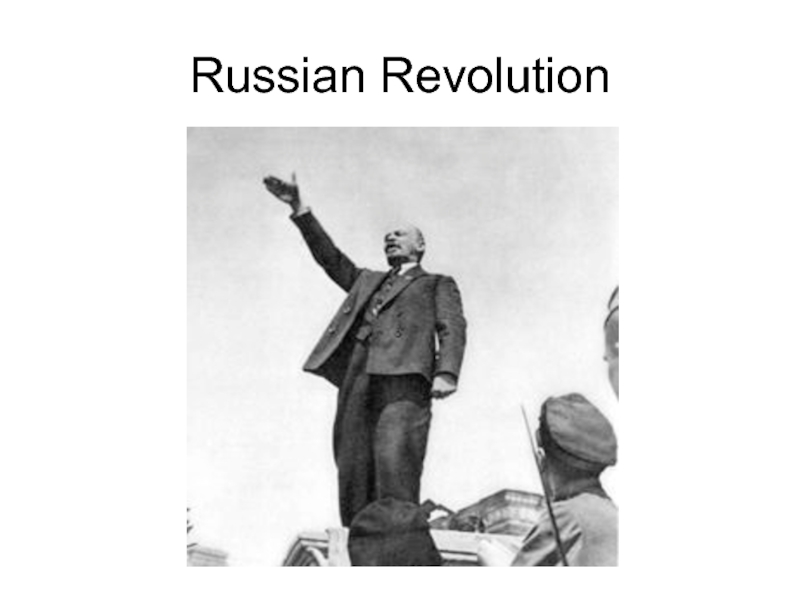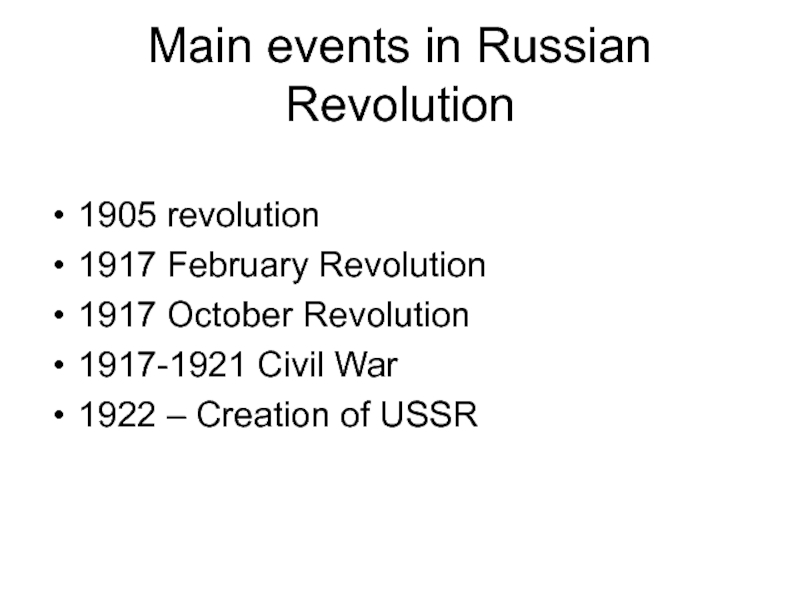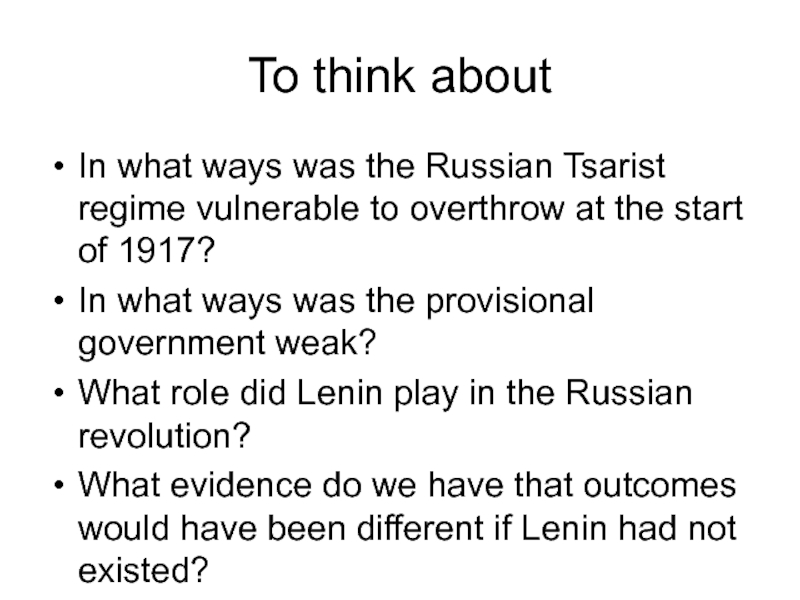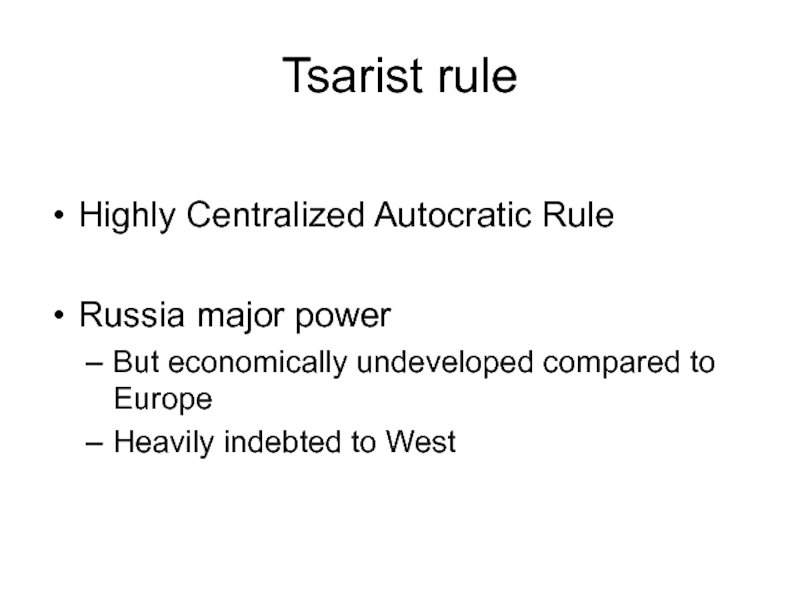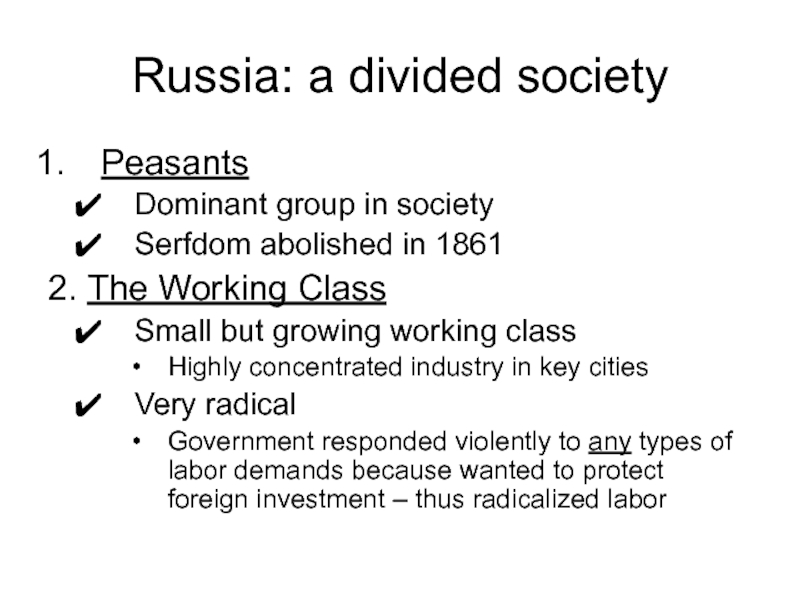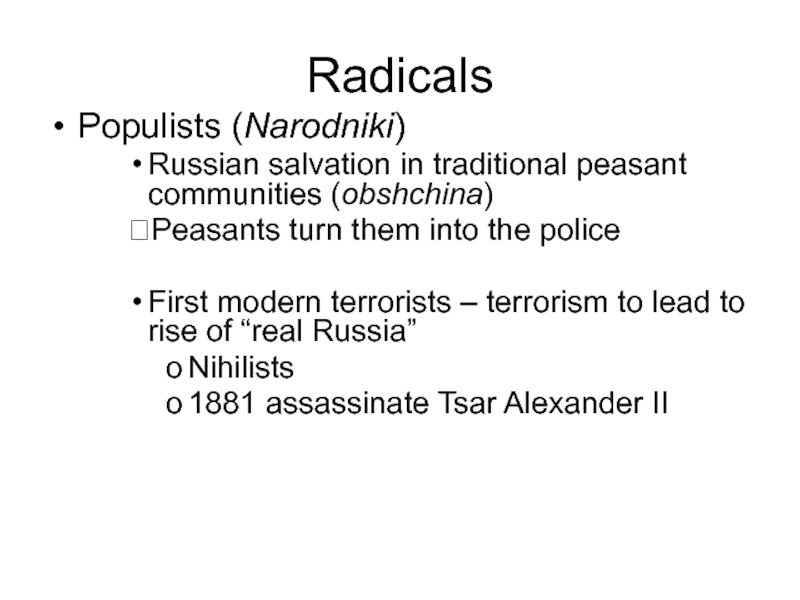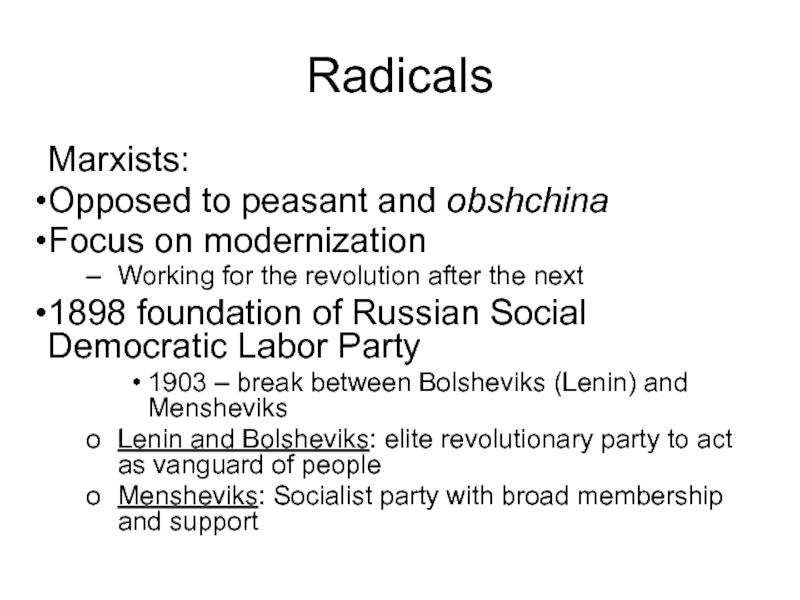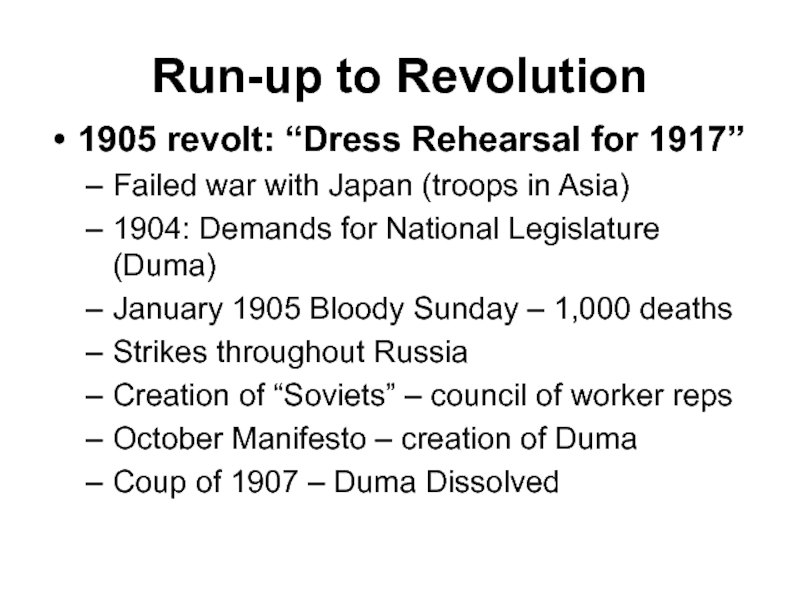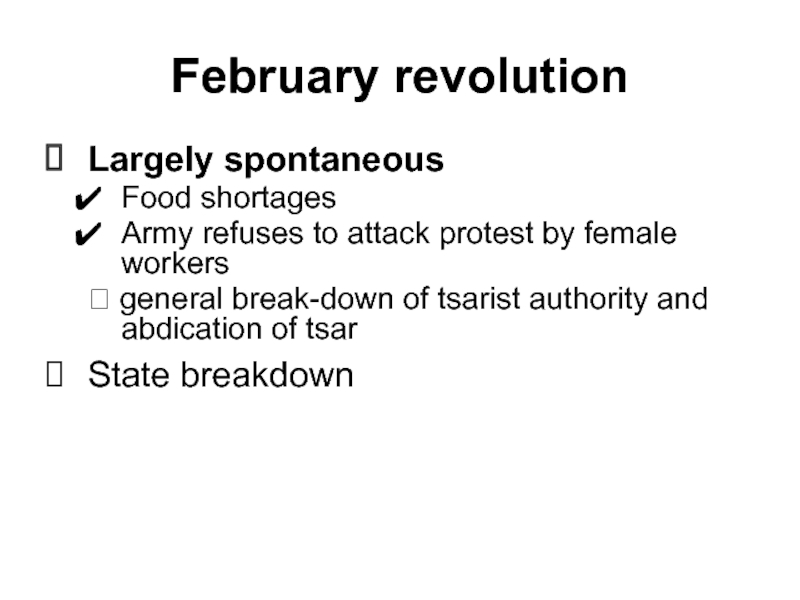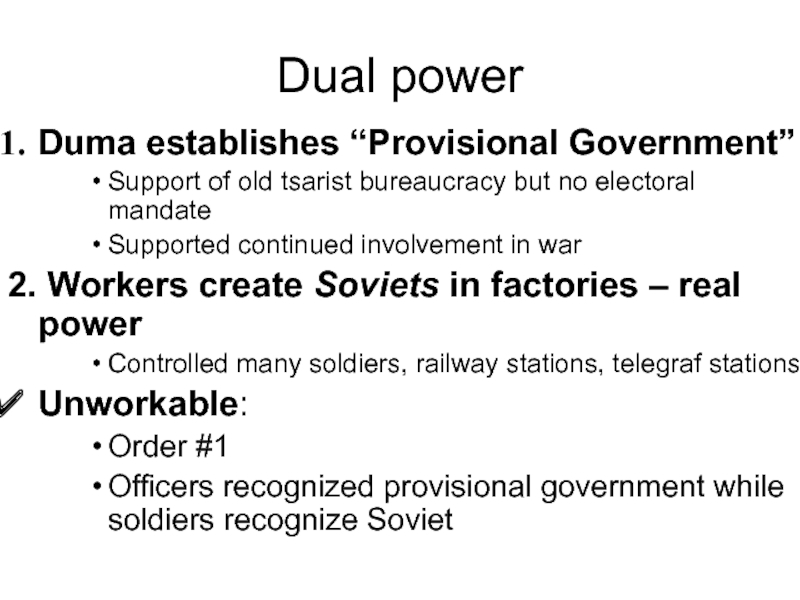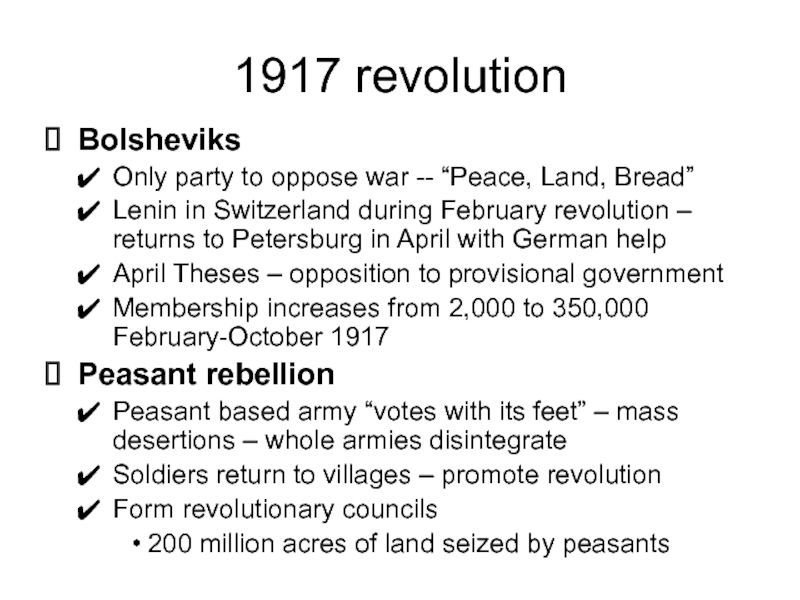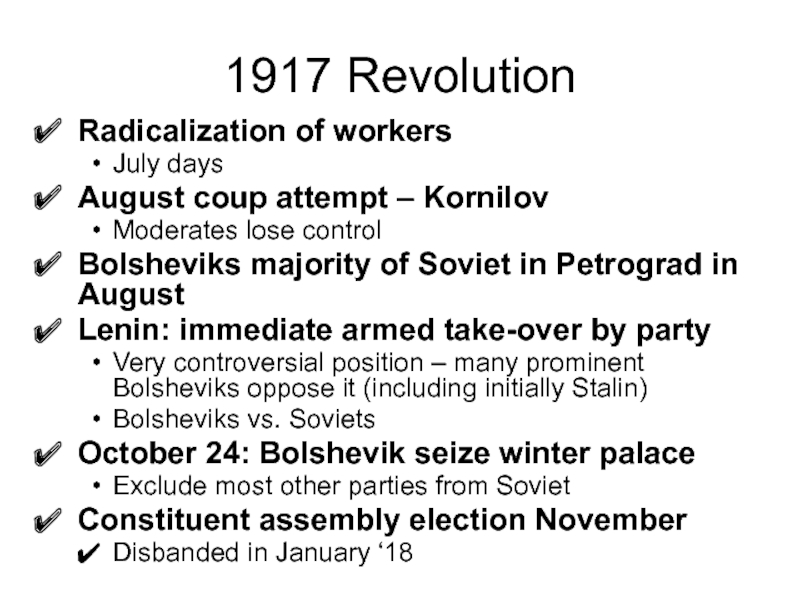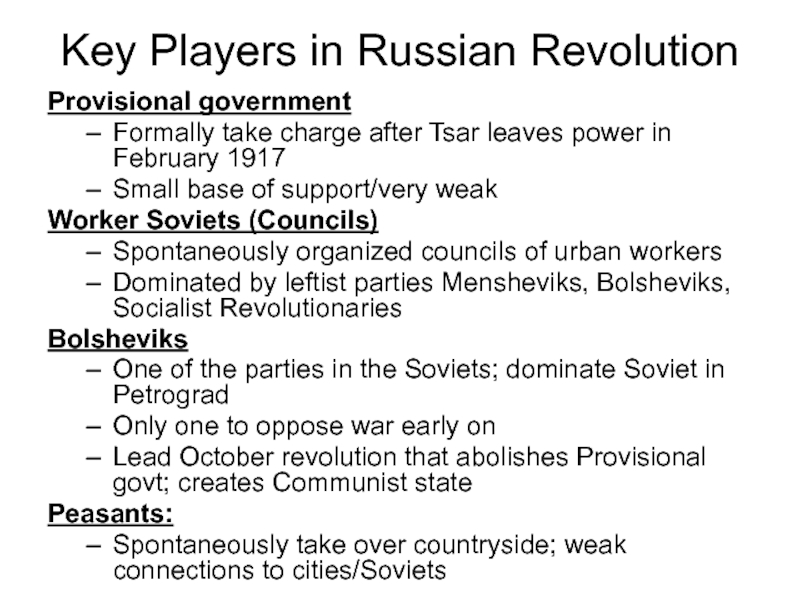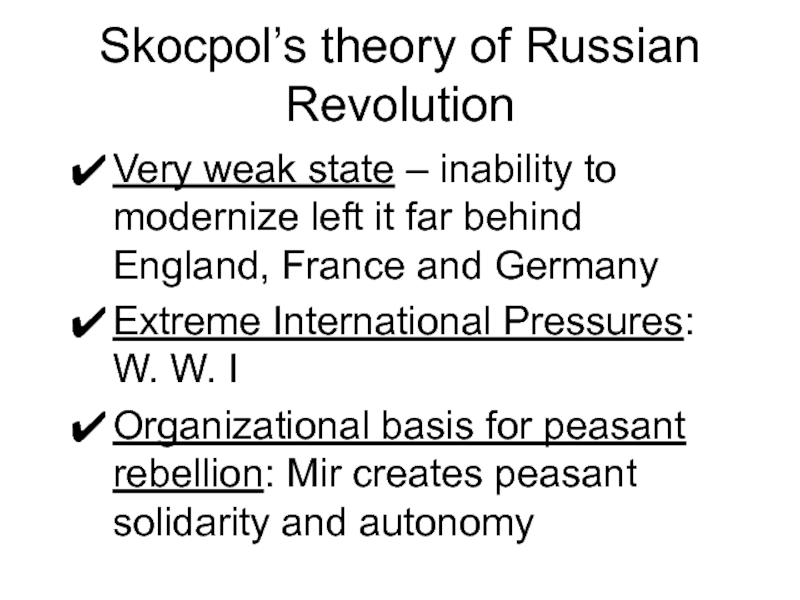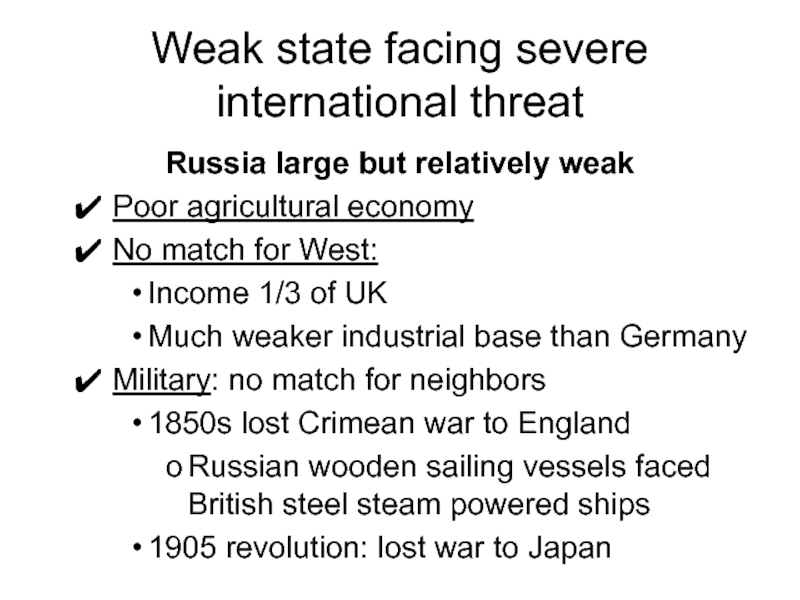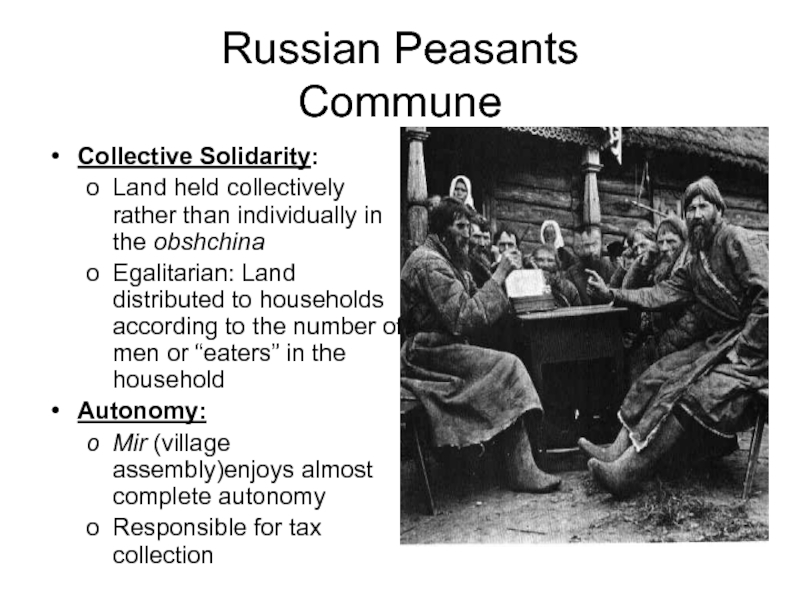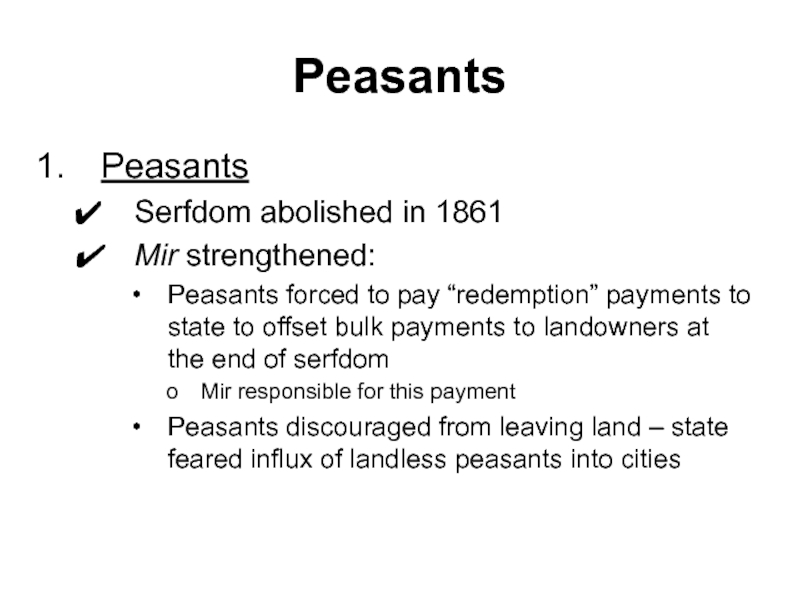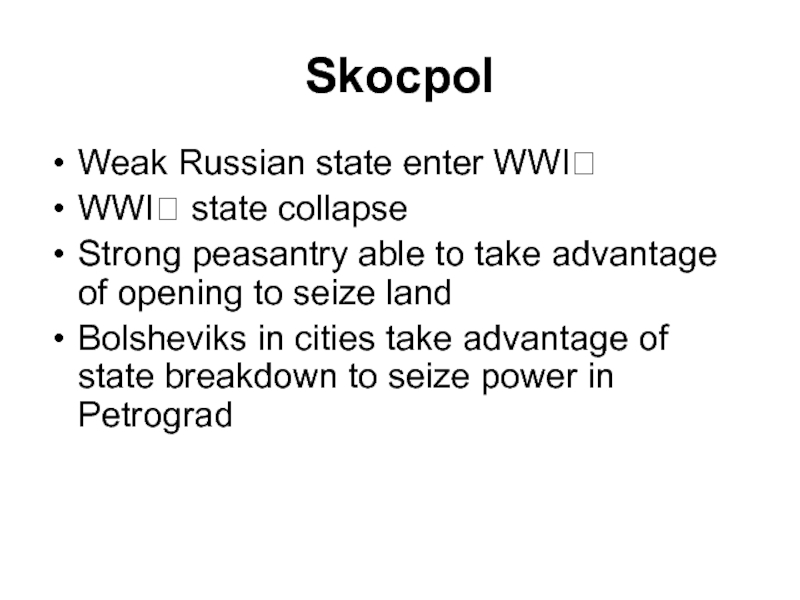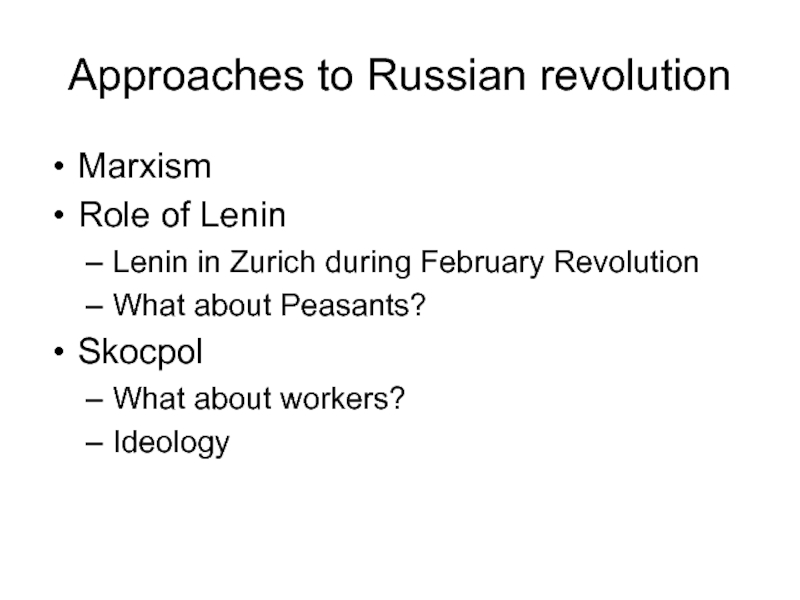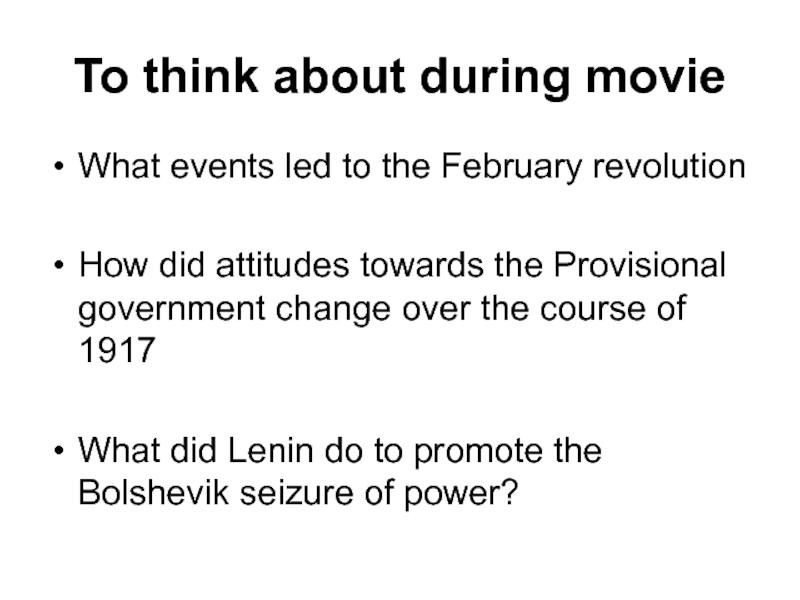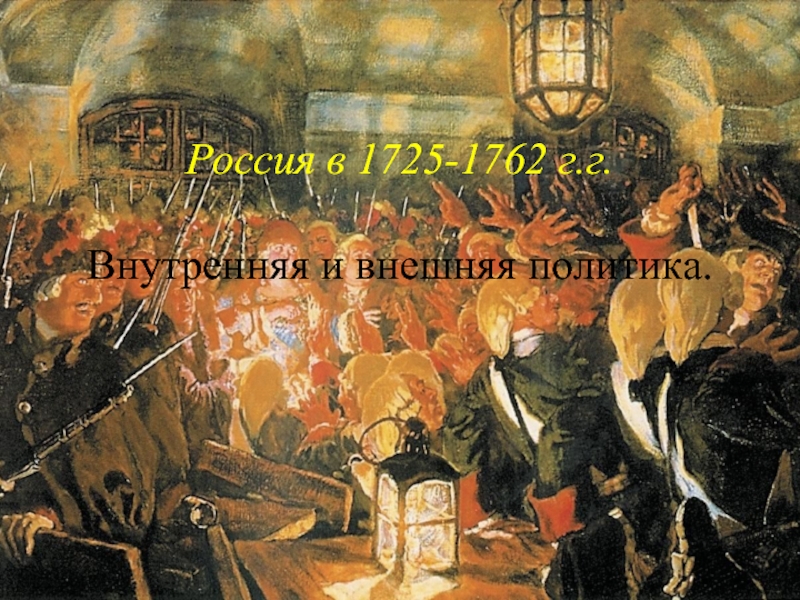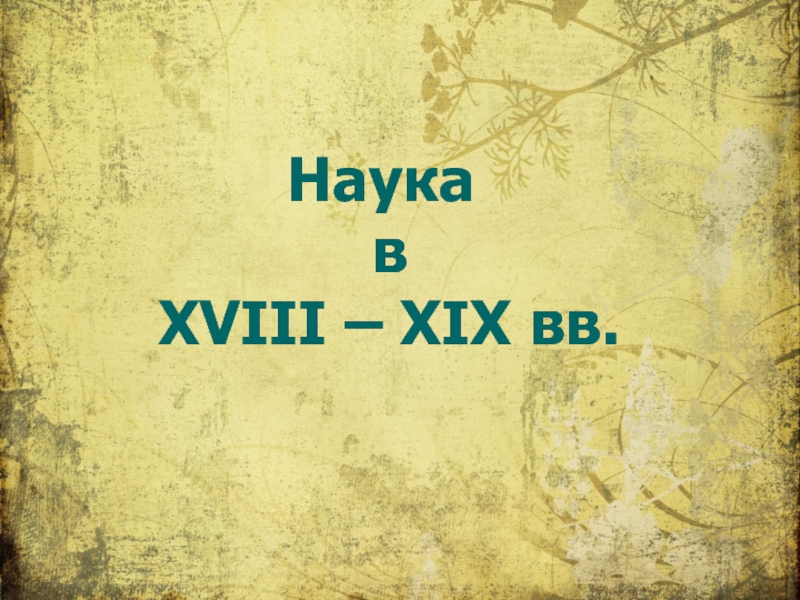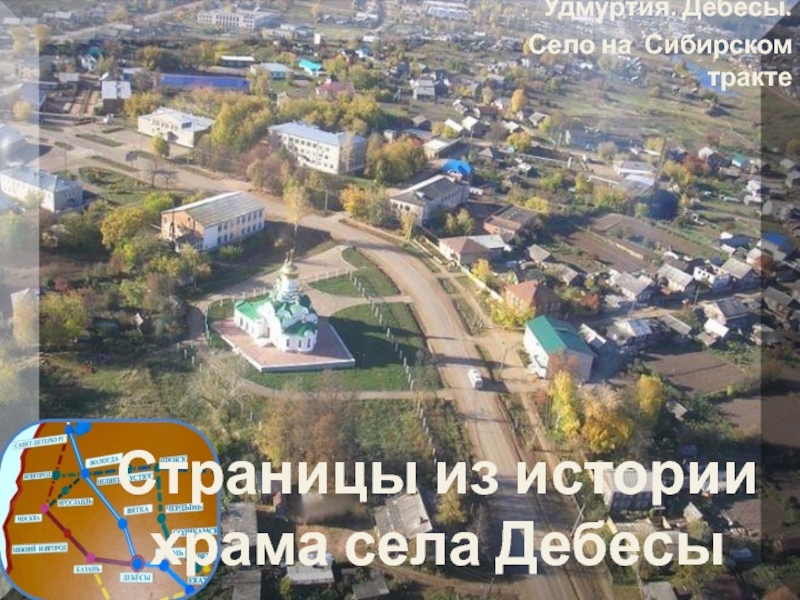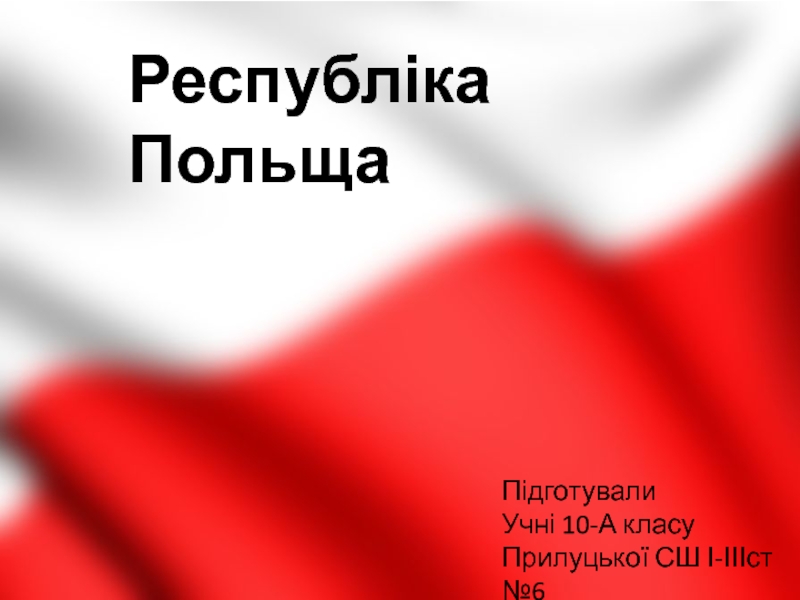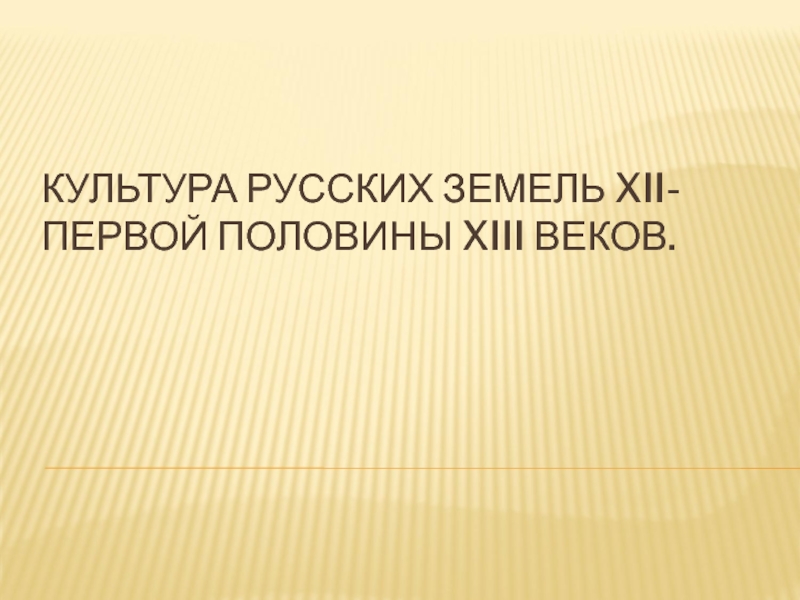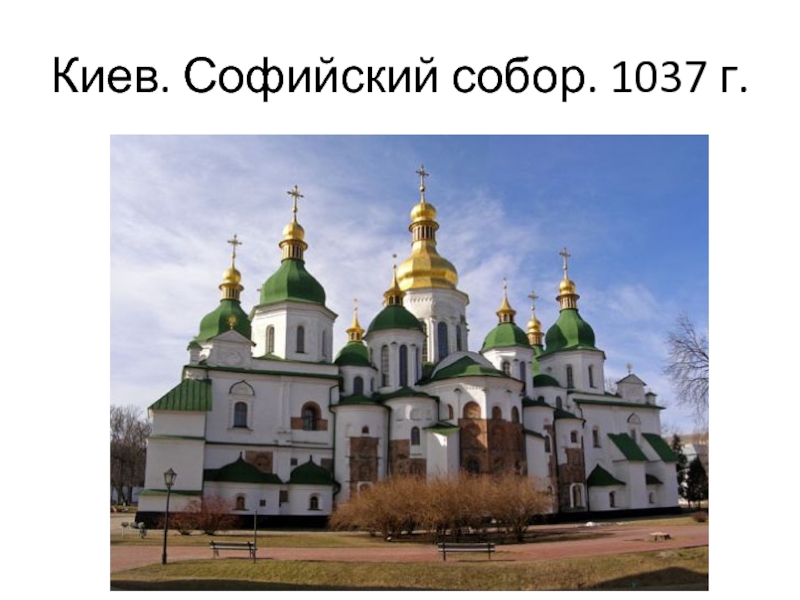- Главная
- Разное
- Дизайн
- Бизнес и предпринимательство
- Аналитика
- Образование
- Развлечения
- Красота и здоровье
- Финансы
- Государство
- Путешествия
- Спорт
- Недвижимость
- Армия
- Графика
- Культурология
- Еда и кулинария
- Лингвистика
- Английский язык
- Астрономия
- Алгебра
- Биология
- География
- Детские презентации
- Информатика
- История
- Литература
- Маркетинг
- Математика
- Медицина
- Менеджмент
- Музыка
- МХК
- Немецкий язык
- ОБЖ
- Обществознание
- Окружающий мир
- Педагогика
- Русский язык
- Технология
- Физика
- Философия
- Химия
- Шаблоны, картинки для презентаций
- Экология
- Экономика
- Юриспруденция
Russian revolution. (Lecture 4) презентация
Содержание
- 1. Russian revolution. (Lecture 4)
- 2. Russian Revolution
- 3. Main events in Russian Revolution 1905
- 4. To think about In what ways was
- 5. Tsarist rule Highly Centralized Autocratic Rule
- 6. Russia: a divided society Peasants Dominant group
- 7. Radicals Populists (Narodniki) Russian salvation in traditional
- 8. Radicals Marxists: Opposed to peasant and obshchina
- 9. Run-up to Revolution 1905 revolt: “Dress Rehearsal
- 10. 1917 revolution World War I: 1914
- 11. February revolution Largely spontaneous Food shortages
- 12. Dual power Duma establishes “Provisional Government” Support
- 13. 1917 revolution Bolsheviks Only party to oppose
- 14. 1917 Revolution Radicalization of workers July days
- 15. Key Players in Russian Revolution Provisional government
- 16. Sources of the Russian Revolution Marxist approach
- 17. Skocpol’s theory of Russian Revolution Very weak
- 18. Weak state facing severe international threat Russia
- 19. Russian Peasants Commune Collective Solidarity: Land held
- 20. Peasants Peasants Serfdom abolished in 1861 Mir
- 21. Skocpol Weak Russian state enter WWI? WWI?
- 22. Approaches to Russian revolution Marxism Role of
- 23. To think about during movie What events
Слайд 3Main events in Russian Revolution
1905 revolution
1917 February Revolution
1917 October Revolution
1917-1921 Civil
War
1922 – Creation of USSR
1922 – Creation of USSR
Слайд 4To think about
In what ways was the Russian Tsarist regime vulnerable
to overthrow at the start of 1917?
In what ways was the provisional government weak?
What role did Lenin play in the Russian revolution?
What evidence do we have that outcomes would have been different if Lenin had not existed?
In what ways was the provisional government weak?
What role did Lenin play in the Russian revolution?
What evidence do we have that outcomes would have been different if Lenin had not existed?
Слайд 5Tsarist rule
Highly Centralized Autocratic Rule
Russia major power
But economically undeveloped compared
to Europe
Heavily indebted to West
Heavily indebted to West
Слайд 6Russia: a divided society
Peasants
Dominant group in society
Serfdom abolished in 1861
2. The
Working Class
Small but growing working class
Highly concentrated industry in key cities
Very radical
Government responded violently to any types of labor demands because wanted to protect foreign investment – thus radicalized labor
Small but growing working class
Highly concentrated industry in key cities
Very radical
Government responded violently to any types of labor demands because wanted to protect foreign investment – thus radicalized labor
Слайд 7Radicals
Populists (Narodniki)
Russian salvation in traditional peasant communities (obshchina)
?Peasants turn them
into the police
First modern terrorists – terrorism to lead to rise of “real Russia”
Nihilists
1881 assassinate Tsar Alexander II
First modern terrorists – terrorism to lead to rise of “real Russia”
Nihilists
1881 assassinate Tsar Alexander II
Слайд 8Radicals
Marxists:
Opposed to peasant and obshchina
Focus on modernization
Working for the revolution after
the next
1898 foundation of Russian Social Democratic Labor Party
1903 – break between Bolsheviks (Lenin) and Mensheviks
Lenin and Bolsheviks: elite revolutionary party to act as vanguard of people
Mensheviks: Socialist party with broad membership and support
1898 foundation of Russian Social Democratic Labor Party
1903 – break between Bolsheviks (Lenin) and Mensheviks
Lenin and Bolsheviks: elite revolutionary party to act as vanguard of people
Mensheviks: Socialist party with broad membership and support
Слайд 9Run-up to Revolution
1905 revolt: “Dress Rehearsal for 1917”
Failed war with Japan
(troops in Asia)
1904: Demands for National Legislature (Duma)
January 1905 Bloody Sunday – 1,000 deaths
Strikes throughout Russia
Creation of “Soviets” – council of worker reps
October Manifesto – creation of Duma
Coup of 1907 – Duma Dissolved
1904: Demands for National Legislature (Duma)
January 1905 Bloody Sunday – 1,000 deaths
Strikes throughout Russia
Creation of “Soviets” – council of worker reps
October Manifesto – creation of Duma
Coup of 1907 – Duma Dissolved
Слайд 101917 revolution
World War I:
1914 Russia forced to take side of
France and England against Germany and Austro-Hungarian empire
15 million Russians mobilized
Most support involvement in war but protests occur because of defeats and shortages
Severe shortages of basic military equipment
Defeats leads to broad disaffection against tsar
1.6-1.8 million dead by 1916;
15 million Russians mobilized
Most support involvement in war but protests occur because of defeats and shortages
Severe shortages of basic military equipment
Defeats leads to broad disaffection against tsar
1.6-1.8 million dead by 1916;
Слайд 11February revolution
Largely spontaneous
Food shortages
Army refuses to attack protest by female
workers
? general break-down of tsarist authority and abdication of tsar
State breakdown
? general break-down of tsarist authority and abdication of tsar
State breakdown
Слайд 12Dual power
Duma establishes “Provisional Government”
Support of old tsarist bureaucracy but no
electoral mandate
Supported continued involvement in war
2. Workers create Soviets in factories – real power
Controlled many soldiers, railway stations, telegraf stations
Unworkable:
Order #1
Officers recognized provisional government while soldiers recognize Soviet
Supported continued involvement in war
2. Workers create Soviets in factories – real power
Controlled many soldiers, railway stations, telegraf stations
Unworkable:
Order #1
Officers recognized provisional government while soldiers recognize Soviet
Слайд 131917 revolution
Bolsheviks
Only party to oppose war -- “Peace, Land, Bread”
Lenin
in Switzerland during February revolution – returns to Petersburg in April with German help
April Theses – opposition to provisional government
Membership increases from 2,000 to 350,000 February-October 1917
Peasant rebellion
Peasant based army “votes with its feet” – mass desertions – whole armies disintegrate
Soldiers return to villages – promote revolution
Form revolutionary councils
200 million acres of land seized by peasants
April Theses – opposition to provisional government
Membership increases from 2,000 to 350,000 February-October 1917
Peasant rebellion
Peasant based army “votes with its feet” – mass desertions – whole armies disintegrate
Soldiers return to villages – promote revolution
Form revolutionary councils
200 million acres of land seized by peasants
Слайд 141917 Revolution
Radicalization of workers
July days
August coup attempt – Kornilov
Moderates lose control
Bolsheviks
majority of Soviet in Petrograd in August
Lenin: immediate armed take-over by party
Very controversial position – many prominent Bolsheviks oppose it (including initially Stalin)
Bolsheviks vs. Soviets
October 24: Bolshevik seize winter palace
Exclude most other parties from Soviet
Constituent assembly election November
Disbanded in January ‘18
Lenin: immediate armed take-over by party
Very controversial position – many prominent Bolsheviks oppose it (including initially Stalin)
Bolsheviks vs. Soviets
October 24: Bolshevik seize winter palace
Exclude most other parties from Soviet
Constituent assembly election November
Disbanded in January ‘18
Слайд 15Key Players in Russian Revolution
Provisional government
Formally take charge after Tsar leaves
power in February 1917
Small base of support/very weak
Worker Soviets (Councils)
Spontaneously organized councils of urban workers
Dominated by leftist parties Mensheviks, Bolsheviks, Socialist Revolutionaries
Bolsheviks
One of the parties in the Soviets; dominate Soviet in Petrograd
Only one to oppose war early on
Lead October revolution that abolishes Provisional govt; creates Communist state
Peasants:
Spontaneously take over countryside; weak connections to cities/Soviets
Small base of support/very weak
Worker Soviets (Councils)
Spontaneously organized councils of urban workers
Dominated by leftist parties Mensheviks, Bolsheviks, Socialist Revolutionaries
Bolsheviks
One of the parties in the Soviets; dominate Soviet in Petrograd
Only one to oppose war early on
Lead October revolution that abolishes Provisional govt; creates Communist state
Peasants:
Spontaneously take over countryside; weak connections to cities/Soviets
Слайд 16Sources of the Russian Revolution
Marxist approach
Role of Lenin
Importance of professionalized and
small revolutionary party
But just how disciplined was the party in 1917?
Lenin and the Provisional government
April Theses
Peasants?
But just how disciplined was the party in 1917?
Lenin and the Provisional government
April Theses
Peasants?
Слайд 17Skocpol’s theory of Russian Revolution
Very weak state – inability to modernize
left it far behind England, France and Germany
Extreme International Pressures: W. W. I
Organizational basis for peasant rebellion: Mir creates peasant solidarity and autonomy
Extreme International Pressures: W. W. I
Organizational basis for peasant rebellion: Mir creates peasant solidarity and autonomy
Слайд 18Weak state facing severe international threat
Russia large but relatively weak
Poor agricultural
economy
No match for West:
Income 1/3 of UK
Much weaker industrial base than Germany
Military: no match for neighbors
1850s lost Crimean war to England
Russian wooden sailing vessels faced British steel steam powered ships
1905 revolution: lost war to Japan
No match for West:
Income 1/3 of UK
Much weaker industrial base than Germany
Military: no match for neighbors
1850s lost Crimean war to England
Russian wooden sailing vessels faced British steel steam powered ships
1905 revolution: lost war to Japan
Слайд 19Russian Peasants
Commune
Collective Solidarity:
Land held collectively rather than individually in the obshchina
Egalitarian:
Land distributed to households according to the number of men or “eaters” in the household
Autonomy:
Mir (village assembly)enjoys almost complete autonomy
Responsible for tax collection
Autonomy:
Mir (village assembly)enjoys almost complete autonomy
Responsible for tax collection
.
Слайд 20Peasants
Peasants
Serfdom abolished in 1861
Mir strengthened:
Peasants forced to pay “redemption” payments to
state to offset bulk payments to landowners at the end of serfdom
Mir responsible for this payment
Peasants discouraged from leaving land – state feared influx of landless peasants into cities
Mir responsible for this payment
Peasants discouraged from leaving land – state feared influx of landless peasants into cities
Слайд 21Skocpol
Weak Russian state enter WWI?
WWI? state collapse
Strong peasantry able to take
advantage of opening to seize land
Bolsheviks in cities take advantage of state breakdown to seize power in Petrograd
Bolsheviks in cities take advantage of state breakdown to seize power in Petrograd
Слайд 22Approaches to Russian revolution
Marxism
Role of Lenin
Lenin in Zurich during February Revolution
What
about Peasants?
Skocpol
What about workers?
Ideology
Skocpol
What about workers?
Ideology
Слайд 23To think about during movie
What events led to the February revolution
How
did attitudes towards the Provisional government change over the course of 1917
What did Lenin do to promote the Bolshevik seizure of power?
What did Lenin do to promote the Bolshevik seizure of power?
